Mighty Yet Stubby: A Four-Legged War Hero Takes D.C. By Storm
Sergeant John J. Curtin found himself dozing while in the trenches during the Battle of Chemin des Dames.[1] Feeling as safe as one could in the break between enemy fire, Sgt. Curtin fell into a deep and bone-tired sleep. His rifle and bayonet were haphazardly strewn across his lap as his back pressed against the cool damp wall of the trench. The duckboard on which he sat just barely kept him protected from the stagnant water that was omnipresent in the dugouts, which scarred the French countryside in 1917 and 1918. The khaki uniform that denoted him as belonging to the 102nd Regiment of the American Expeditionary Force (AEF) was stained with dirt, sweat, and perhaps even a little blood from the seemingly endless death and destruction which surrounded him.
Despite being scared beyond his wit’s end that he would not be able to react in time to save himself from a deadly German artillery shell, exhaustion hung over him like a weighted blanket. Closing his eyes for a few minutes would not hurt anyone, he decided. With his chin tilted forward resting against his sternum and his helmet falling down to just block out the light, Sgt. Curtin fell into the sort of sleep one experiences while under extreme stress and deprivation.
Seemingly just as soon as he began dreaming of his home in Connecticut, Sgt. Curtin was abruptly awoken by the frantic howling and barking of a dog.[2] As he quickly came to, he realized all too fast what was going on. Stubby, the 102nd’s dog, was warning him of an impending mustard gas attack by the Germans, located just a few hundred yards across “no man’s land.”[3] With great haste, Sgt. Curtin secured his gas mask upon his face, grabbed the mutt, and traversed the maze of trenches in the hopes of evading the noxious chemicals.[4]
Once the man and pooch reached relative safety— only experiencing minor injuries from exposure to the thick yellow fog— the weight of what Curtin just went through hit him like a ton of bricks: he was nearly killed by the German gas. The only reason his body was not lifeless at his duty station was because of the heroics of Stubby.[5] This was neither the first nor the last time Stubby had saved an American Service member. But Stubby was no specially trained dog – he was not even supposed to be in the war at all.[6]
Stubby’s illustrious story begins across the pond in New Haven, Connecticut, with one special man. After being drafted into the Army National Guard at the United States’ entrance into the Great War, Robert J. Conroy was sent from his home in New Britain, Connecticut, to the campus of Yale University where he and his fellow members of the 102nd Infantry Regiment of the 26th Division were preparing for war.[7] A stray dog with a short tail, made Conroy’s acquaintance (most likely due to the food Conroy gave the pup).[8] Soon enough, the two were inseparable, with Conroy spending his free time teaching the newly named dog, Stubby, a variety of tricks, including how to salute.[9] The brindle Boston bull terrier shortly became as much a part of the 102nd as Conroy, himself.[10]
Although the pair had not known each other long when it was time for the 102nd to ship out to Europe, Conroy decided he couldn’t leave Stubby behind. But getting the canine to France would take some doing as Army rules forbid the possession of personal pets.
When the Regiment shipped out of Connecticut, Conroy smuggled Stubby onto the troop train that brought them down to Newport News, Virginia. The next step would be more tricky: how to get Stubby on board the transport ship, Minnesota, and keep him hidden for the entire voyage to France.[11] First, Conroy concealed his pup in an oversized Army blanket as a means to get him up the gangplank and onto the vessel.[12] Once making it aboard, Conroy made a beeline to the Fireman’s room where he stashed Stubby in a coal box.[13]
With a number of men from the 26th Division checking on Stubby periodically throughout the day, it was only a matter of time until the canine’s presence would be revealed. As the legend goes, Conroy’s commanding officer came to hear about the then well known stowaway on the Minnesota.[14] Catching Conroy with Stubby, the officer was not impressed. . . until he was. Upon their discovery, Conroy directed Stubby to salute the officer as Army doctrine dictated.[15] Caught off guard by the dog sitting at attention with his paw raised in salute, the officer allowed Stubby to stay with the men.[16] When the ship reached St. Nazaire, France, special permission was obtained for Stubby to accompany the Yankee Division to the frontlines of the war, now as their official mascot.[17]
This is where Stubby’s duty with the AEF properly began. His initial role was as a morale builder for the men on the front. He would walk up and down the long and winding trenches, providing support to the largely young and stressed out men.[18] Seeing the familiar face and furiously wagging nub of a tail provided the servicemen a sense of calm while under enemy fire. When he heard loud and intense instances of gun fire, Stubby quickly learned to dive for the trenches, just like the men of his division.[19]
As he grew more comfortable with the sounds and sites of being at war, Stubby began taking on more responsibilities than just that of mascot. He became a caretaker and protector. When a man was hurt on the battlefield, Stubby would seek them out and stay with the soldier until a medic came to aid the injured.[20] It was as if Stubby knew the men needed help and wanted to comfort them in their time of need.
But the rogue dog did not stop there. Once, he quite literally caught a German spy. During the battle of Chemin des Dames, the pup launched himself out of the relative security of the allied trenches and into the hellscape known as “no man’s land.”[21] Before anyone knew, the loud cry of a man came from the war-stricken landscape above the AEF men. “Kamarad” was heard being shouted repeatedly from the direction where Stubby had bolted off.[22] When men of the 26th located Stubby, they found him latched on to the leg of a German soldier wearing an American uniform.[23] The intruder was trying to conduct reconnaissance on the Allied trenches, but Stubby was not fooled.[24] Between his keen sense of smell and because he could differentiate between German and English, Stubby knew who was friend and who was foe, and tracked down the spy.[25] For his valor in combat, Stubby was made a Sergeant in the 102nd Regiment, making him the first dog to receive a rank in the United States Armed Services.[26]
Outside the American soldiers, Stubby was beloved by the allied forces and the French citizenry, alike. His reputation preceded him. While Conroy and Stubby were on leave in Paris, countless British, French, and Australian service members stopped the dynamic duo on the streets, wanting to meet the hero dog. In appreciation for his service, three French women made him a chamois blanket which he proudly wore draped across his back like a uniform.[27] It became tradition to pin medals onto the blanket such as a supposed Iron Cross stolen from the aforementioned spy.[28]
Despite all the morale boosting, soldier saving, and spy catching Stubby performed for the Army, his luck took a turn. While serving in the Toul sector, the brave mutt took advantage of a lull in the fighting to jump out of the dugout and onto the deadly no man’s land, perhaps to search for the lost and wounded. Out of nowhere, the shelling picked back up again. Before he could react, a mortar round exploded some twenty-feet behind the canine.[29] The blast lodged a piece of shrapnel in his breast.[30] The poor pooch was rushed to a field hospital where army surgeons removed the afflicting metal.[31] The injury proved not to be fatal, much to the 26th Division’s relief, and the feisty furry friend was back at the front with his men, just a mere six weeks later.[32]
Stubby was loved by all who knew him, but especially by Sgt. Curtin, who he had saved from the gas attack. As a tribute to the woofing warrior, Curtin wrote the following poem on the inside of his helmet:
Listen to me and I will tell
Of a dog who went all through hell,
With the 102nd infantry, USA,
“Stubby" was with us night and day.
He was smuggled across the sea,
And was certainly full of glee,
When he landed at St. Nazaire,
He and Bob were a happy pair.
Near Neufchâtel’s he stayed a while,
And in hiking covered many a mile;
Then in February we left for the front,
And “Stubby” was ready to do his stunts.
A month and a half on Chemin des Dames,
“Stubby” behaved just like a lambs,
Then he went to Beaumont, near Toul,
“Stubby” showed he was no fool.
He always knew went to duck the shells,
And buried his nose at the first gas smells,
But once a small fragment stuck in his breast,
Slightly wounded in action, was “Stubby” blessed.
He went all through Château Thierry drive,
And came out of it very much alive;
Then to St. Mihiel “Stubby” came,
And helped those Germans from the plain.
North of Verdun where our hardest battles,
And mony a brave man cave tap rattles,
But “Stubby” came through hell O.K.
And is ready to go back to the USA.
He is a fighting bull dog from the old Y.D.
And is the joy in pride of our company,
When we taking back to the USA,
“Stubby” Will hold the stage night and day.
His owner Bob will take him home,
And nevermore willl “Stubby” roam;
He will enjoy a much earned rest,
In the place we all love best.[33]
When the war finally ended on November 11, 1918, and the AEF was finally sent home, Stubby had been overseas for some eighteen months. On Christmas Day, 1918, toward the end of his tour of duty, the dog met President Woodrow Wilson.[34] Just a few weeks after the end of the war, Wilson was in France, reviewing the troops and, of course, had to meet the famous war dog.[35] The two were reported to have shaken paws.[36] As it turned out, they would soon be neighbors in Washington.
Upon Stubby’s departure from France, Conroy once again had to smuggle the canine aboard the troop ship home (probably with less effort as Stubby was famous and officers would most likely have turned a blind eye).[37] Adjusting back to civilian life, Conroy and Stubby made their new home in Washington, DC where Conroy attended Catholic University Law School.[38] Not to be out done by his owner, Stubby made a name for himself among the students. During halftime at the school football games, the dog veteran would take the field, chasing and playing with the game ball.[39] Some say Stubby’s antics were the inspiration for the modern halftime show.[40]
But Stubby’s celebrity status was only beginning. He became a fixture in the District, especially at events that pertained to the Great War. For example, he led any and all American Legion Parades as well as visited convalescing WWI vets at Walter Reed Hospital.[41] In a noteworthy ceremony in the Capitol, Stubby was presented to General “Black Jack” Pershing (commander of the AEF) and awarded a special gold medal by the Humane Education Society.[42] He was additionally made a lifetime member of the Red Cross, the American Legion, and the Y. M. C.A, the last of which promised to give the Bull Terrier three bones a day and a place to sleep for the rest of his life.[43]
Over the course of his civilian life, Stubby would meet two more Presidents.[44] In 1921, Stubby met President Harding and later headlined an animal parade alongside First Dog Laddie Boy.[45] A few years later, Stubby and Conroy had the unusual honor of being invited to the White House for a formal audience with President Coolidge.[46]
Stubby, the woofing warrior of World War I, lived a happy and relaxing life in DC. Unfortunately, however, all great animal stories must come to an end. At the ripe age of 14, Stubby passed away in the arms of his best friend, Robert Conroy, on March 16, 1926.[47] Conroy, knowing the nation was not ready to forget Stubby, sent the dog to the Smithsonian’s taxidermy office, where Stubby was preserved for future generations.[48] For some thirty years, the mighty Stubby stood on display at the Red Cross Museum on 17th St., NW, proudly wearing his chamois blanket, adorned with his numerous medals, three service stripes, and one wound stripe.[49]
Although Stubby can no longer be viewed by the public (he now sits in a storage box in the Smithsonian), his impact on the military looms large. Stubby illustrated just how dogs could be used in combat. By the Second World War, and the creation of the Army’s K-9 unit in 1942, dogs would be an accepted part of the American military and the way they conducted battle.[50] Of course, Stubby doesn’t get sole credit for this new animal strategy – canines have been used in military operations for hundreds of years. But it’s safe to say that his exemplary service on the front lines in France helped pave the way for working dogs of all kinds today.
Stubby, the mighty war dog of the 26th Yankee Division, may be gone, but let him not be forgotten.
Footnotes
- ^ Ralph J. Kelley, “Stubby, the Canine Hero of the A.E.F.,” The Washington Post (Washington, DC), November 15, 1925.
- ^ Ibid.
- ^ Ibid.
- ^ Ibid.
- ^ Ibid.
- ^ “Stubby, War Hero, Placed in Museum,” The Evening Star (Washington, DC)” January 26, 1927.
- ^ Harry L. Rogers, “Hero Pup Pays call on Buddies of World War,” The Omaha Daily Bee (Omaha, NE), September 25, 1921.
- ^ Ibid.
- ^ “Stubby: Object Description,” si.edu, the Smithsonian, accessed July 24, 2022.
- ^ “Stubby, Dog War Vet Presented to Coolidge,” The Washington Times (Washington, DC), November 1, 1924.
- ^ “Stubby, War Hero, Placed in Museum.”
- ^ Kelley, “Stubby, the Canine Hero of the A.E.F..”
- ^ Ibid.
- ^ “Stubby: Object Description,” si.edu.
- ^ Ibid.
- ^ Ibid.
- ^ “A Unique Honor,” The Bridgeport Times (Bridgeport, CT), July 8, 1921.
- ^ Michael G Lemish, War Dogs: Canines in Combat (USA: Brassey's, 1996).
- ^ “Stubby, War Hero, Placed in Museum.”
- ^ Ibid.
- ^ Kelley, “Stubby, the Canine Hero of the A.E.F..”
- ^ Ibid.
- ^ Ibid.
- ^ “Stubby: Object Description,” si.edu.
- ^ Ibid.
- ^ Ibid.
- ^ “Stubby,’ Dog Hero of World War, Will Receive Another Decoration,” The Evening Star (Washington, DC), December 5, 1927.
- ^ Kelley, “Stubby, the Canine Hero of the A.E.F..”
- ^ “Stubby, War Hero, Placed in Museum.”
- ^ Rogers, “Hero Pup Pays call on Buddies of World War.”
- ^ Ibid.
- ^ Ibid.
- ^ Kelley, “Stubby, the Canine Hero of the A.E.F..”
- ^ ‘“Stubby,’ Dog Hero of World War, Will Receive Another Decoration.”
- ^ Ibid.
- ^ Ibid.
- ^ “Stubby, War Hero, Placed in Museum.”
- ^ “Stubby: Brave Soldier Dog of the 102nd Infantry,” portal.ct.gov, Connecticut Military Department, accessed July 24, 2022. Some sources say he went to Georgetown Law but a newspaper article from while Conroy was in law school said he went to Catholic University, hence why that is written in the text.
- ^ Stubby, War Dog Hero Will be C.U. Mascot in State Game,” The Washington Post (Washington, DC), November 1, 1920.
- ^ “Stubby: Brave Soldier Dog of the 102nd Infantry.”
- ^ “Stubby, War Hero, Placed in Museum.” And “Stubby, War Dog Vet, Presented to Coolidge.”
- ^ “War Dog Decorated,” The Evening Star (Washington, DC), July 7, 1921.
- ^ “Stubby: Brave Soldier Dog of the 102nd Infantry.”
- ^ ‘“Stubby,’ Dog Hero of World War, Will Receive Another Decoration.”
- ^ “Animal Parade Today Will Pass up Avenue,” The Evening Star (Washington, DC), May 13, 1921.
- ^ “Stubby, Dog War Vet Presented to Coolidge.”
- ^ “Stubby Dies: Dog Gained Fame in War,” The Washington Post (Washington, DC), May 17, 1926.
- ^ “Stubby, War Hero, Placed in Museum.”
- ^ Ibid.
- ^ “Four-Legged Fighters,” defense.gov, US Department of Defense, accessed August 4, 2022.


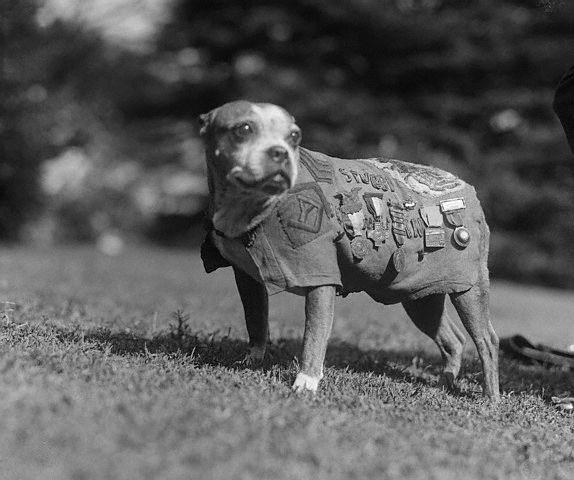

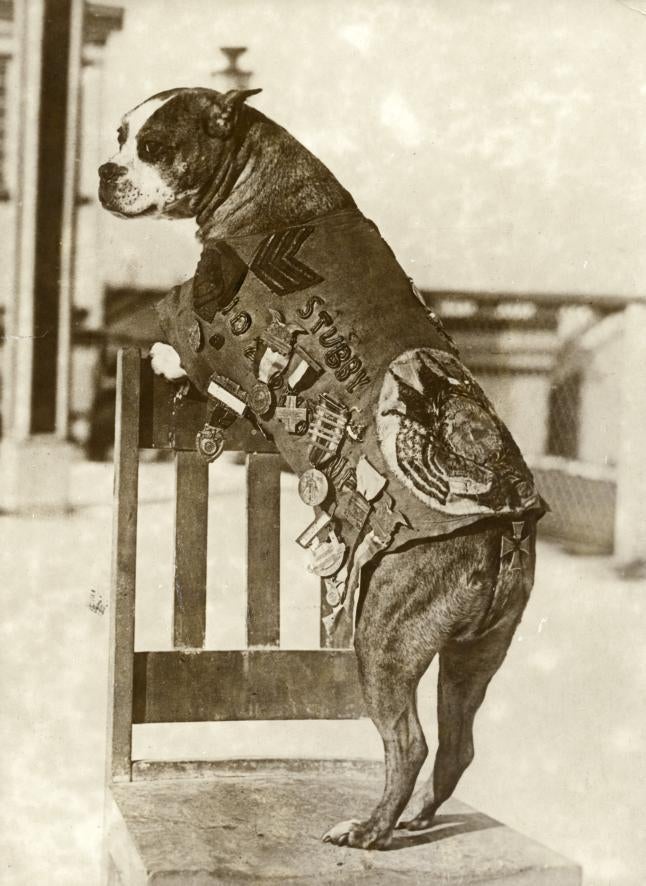

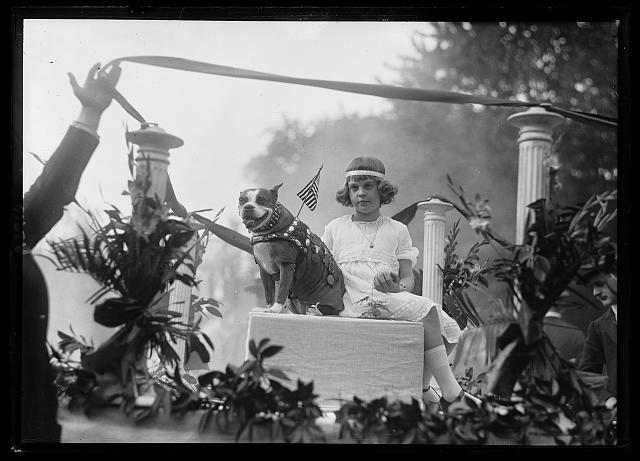
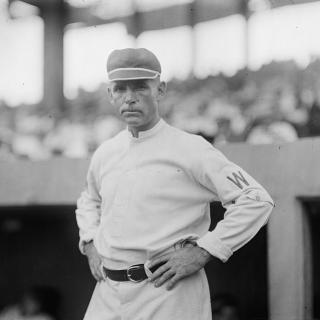

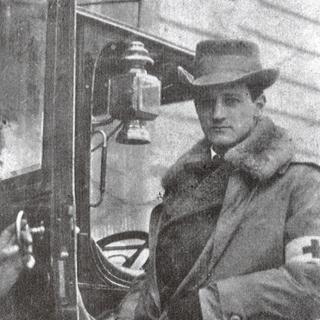
![Sketch of the mythical fuan by Pearson Scott Foresman. [Source: Wikipedia]](/sites/default/files/styles/crop_320x320/public/2023-10/Goatman_Wikipedia_Faun_2_%28PSF%29.png?h=64a074ff&itok=C9Qh-PE1)












